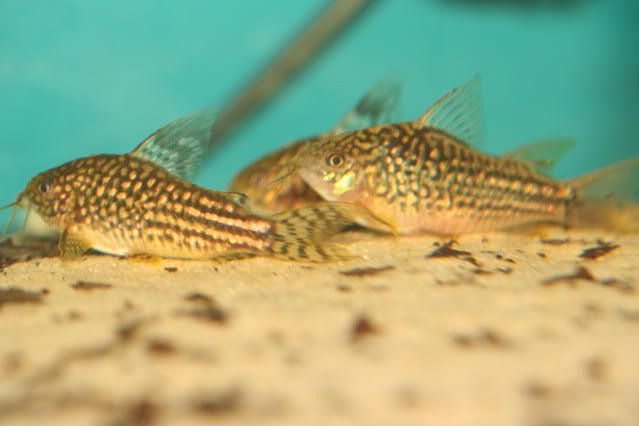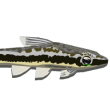infertile eggs
-
RIPbiglad
- Posts: 61
- Joined: 20 Dec 2008, 20:18
- My cats species list: 5 (i:0, k:0)
- Location 2: Sheffield, UK
infertile eggs
I have a group of Corydora Napoensis that are spawning regular but there seems to be a very low fertility rate on them. Over the last 4 nights I must have had 250 + eggs. I had a spawn last week as well but only seem to have had half a dozen hatch so far and can see lots of white eggs.
I know I have more females to males but would adding more males help the fertility rate?
The tank is 24 x 12 x 12 and there are just the 8 napos in it.
I know I have more females to males but would adding more males help the fertility rate?
The tank is 24 x 12 x 12 and there are just the 8 napos in it.
- pleco_breeder
- Posts: 892
- Joined: 09 Dec 2003, 16:51
- My articles: 2
- My cats species list: 17 (i:0, k:0)
- Location 1: Arizona
- Interests: breeding plecos and corys
- Contact:
Re: infertile eggs
I'm following along closely on this one because I have the same problem with a couple of different species. I've noticed that at least one species, C. hastatus, improved when I lowered the pH and hardness a bit. Others still have me stumped.
Larry
Larry
Impossible only means that somebody hasn't done it correctly yet.
-
RIPbiglad
- Posts: 61
- Joined: 20 Dec 2008, 20:18
- My cats species list: 5 (i:0, k:0)
- Location 2: Sheffield, UK
Re: infertile eggs
Thanks Larry
Last time they bred last year there was a high hatch rate. Someone on another site says that there could be a bacteria in the water.
Think Im going to up the water changes to try and improve the water quality
Last time they bred last year there was a high hatch rate. Someone on another site says that there could be a bacteria in the water.
Think Im going to up the water changes to try and improve the water quality
-
wrasse
- Posts: 761
- Joined: 16 Feb 2007, 10:13
- My articles: 1
- My images: 9
- My cats species list: 22 (i:0, k:0)
- My aquaria list: 1 (i:0)
- Spotted: 5
- Location 1: Pailton, Warwickshire, UK
- Location 2: Pailton, Warwickshire, UK
- Interests: catfish, photography, gym, cooking
Re: infertile eggs
I bred Cory Napoensis last year. PH 6.5, temp 78degF, 50% wc every week. A varied diet, including very finely chopped earthworm.
2 males and 1 female pictured below, but only 1 male took part in the spawning.
Once they started spawning regularly I found I could trigger a spawn 'on command' by feeding frozen bloodworm the day before.
The eggs were laid all over the tank, but mainly on the tank glass about half way up, in clusters. It was a big spawning, at least 150, so it was easier to remove the parents and leave the eggs. I didn't have any methylene blue and lost a lot to fungus, but still raised over 30.
The parents are now in semi-retirement

2 males and 1 female pictured below, but only 1 male took part in the spawning.
Once they started spawning regularly I found I could trigger a spawn 'on command' by feeding frozen bloodworm the day before.
The eggs were laid all over the tank, but mainly on the tank glass about half way up, in clusters. It was a big spawning, at least 150, so it was easier to remove the parents and leave the eggs. I didn't have any methylene blue and lost a lot to fungus, but still raised over 30.
The parents are now in semi-retirement

- Coryman
- Expert
- Posts: 2119
- Joined: 30 Dec 2002, 19:06
- My articles: 12
- My catfish: 5
- My cats species list: 83 (i:3, k:0)
- My BLogs: 1 (i:0, p:46)
- Spotted: 194
- Location 1: Kidderminster UK
- Location 2: Kidderminster, UK
- Interests: Cory's, Loricariids, photography and more Cory's
- Contact:
Re: infertile eggs
The best odds for spawning C. napoensis, as is with most of the 'elegans' types is to have at least two males for every female. My most successful spawning came in water with a pH of 7.4 Hardness of 12 dGH and Temperature of 74ºF. The adults were removed from the tank and the water treated with methylene blue. These days however I tend to use a natural anti fungal remedy which is adding three or dried four Alder cones from the Black Alder tree (Alnus glutisoma), the cones release tannin into the water, which lightly (depending on the number of cones used)coat the eggs protecting them from fungal attack.
I would suggest that you reduce the number of females in the breeding group so that there are more males.
Ian
I would suggest that you reduce the number of females in the breeding group so that there are more males.
Ian
-
RIPbiglad
- Posts: 61
- Joined: 20 Dec 2008, 20:18
- My cats species list: 5 (i:0, k:0)
- Location 2: Sheffield, UK
Re: infertile eggs
Thanks Ian.
Over the last 8 or so nights I have taken eggs from the bottom of the tub floating in the tank. I have had a fair few hatch now using alder cones and seem to be getting a lot less fungus on the eggs. I have had no choice for now but to leave all the adults together till I manage to sort some room
Over the last 8 or so nights I have taken eggs from the bottom of the tub floating in the tank. I have had a fair few hatch now using alder cones and seem to be getting a lot less fungus on the eggs. I have had no choice for now but to leave all the adults together till I manage to sort some room
-
RIPbiglad
- Posts: 61
- Joined: 20 Dec 2008, 20:18
- My cats species list: 5 (i:0, k:0)
- Location 2: Sheffield, UK
Re: infertile eggs
tonight is the first night that I havent had eggs






